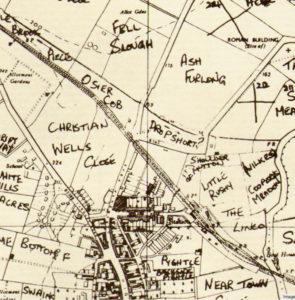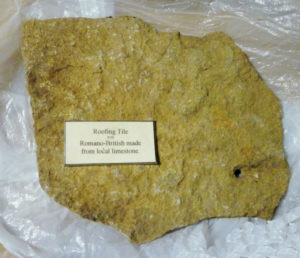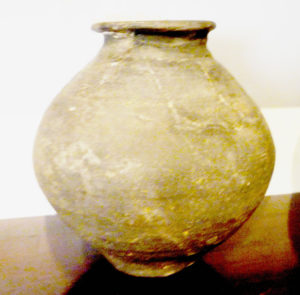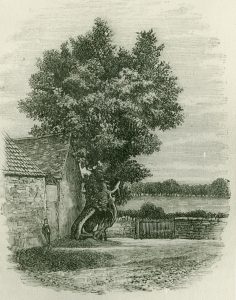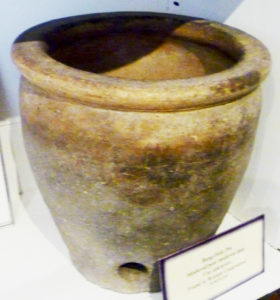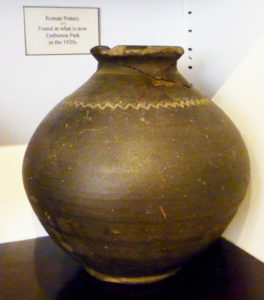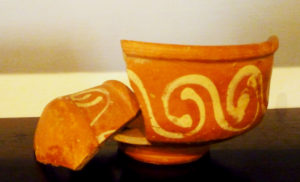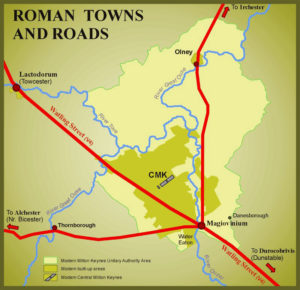Click (most) of the images for an enlarged view.
There have been a number of discoveries of Roman sites and artefacts within the parish of Olney. For example, a second century water channel/gully was discovered during an evaluation in the garden of 106 High Street, and a ditch at East Street. An excavation at Olney’s Cowper Tannery produced significant amounts of Roman pottery which was largely residual.
Although there have been a number of artefacts discovered within the town, including coins and Roman pottery, there has been nothing to suggest a settlement in the area of the town centre. However, the most significant Roman site has been found just beyond the bounds of the town in Ashfurlong, (see map.) An extensive Roman settlement was first noted in the 19th century when large amounts of pottery and considerable quantities of coins were observed in the fields. It is also reputed that a bronze figure of Mercury was also recovered around 1862. There is also a dense scatter of building debris in an adjacent field including roofing tile, box and flue tile. Aerial photographs of the site have revealed linear features that may be indicative of enclosures, field systems and a possible road. Analysis of pottery and finds around the site has indicated a date range of the 2nd to 4th centuries AD, although the finds from one field has yielded evidence for 1st century AD.
Apart from a few surveys there has been no substantive excavation of Ashfurlong, but from current evidence the site has been interpreted as a Roman village or proto-urban settlement (an historic settlement which has both rural and urban features), one of only two known in the county. As a consequence Ashfurlong is of national importance and this is reflected in its designation as a Scheduled Ancient monument (SAM MK 127).
The approximate extent of the Ashfurlong settlement is not fully understood and it may have extended into Olney itself. The land immediately to the north of the Knoll at the north end of Olney is known locally as the old churchyard on account of burials unearthed there in the 19th and 20th centuries. (See image of the ‘Churchyard Elm’.) These graves have been traditionally attributed to an Anglo-Saxon or early medieval church as most are devoid of grave goods and are orientated east west. However an alternative view is that these may well be part of a Roman burial ground outside the Ashfurlong settlement or a roadside cemetery, although further research is needed to confirm either hypothesis.
Beyond Ashfurlong there are a number of Roman sites in the landscape surrounding Olney. A few kilometres to the east of the town at Rines Hill, Newton Blossomville, excavation evidence and aerial photographs have indicated the site of a Roman villa. While at nearby Weston Underwood there is archaeological evidence of another possible villa, a number of Roman finds with Roman tegula (overlapping roof tiles) and building materials have been found to the of west of the village.
.
To the south of Olney there is evidence of another Roman settlement at Emberton Park. Excavations here revealed Romano dripping wells; at the bottom of one well was a limestone slab with relief carving of Mercury. Recent aerial photographic evidence has also revealed a further probable villa site to the south of Olney in Emberton parish.
Ashfurlong and surrounding settlements were connected to a road network; a study undertaken by a group of antiquarians known as the Viatores postulated that there were two principal roads running through the area: the so called Viatores 171 and 175 (Viatores 1964). The most prominent route is the Viatores 175, which is believed to run from Peterborough via Ashfurlong through Olney south to Newport and Fenny Stratford. Given the increasing number of Roman sites being discovered, it seems there must have been a network of lesser roads and routeways in use that connected places together.
To date there are some indications of Roman settlements around Olney, although the proximity of sites discovered at Ashfurlong and Emberton suggest that it is possible that some form of settlement may have existed in Olney itself.

